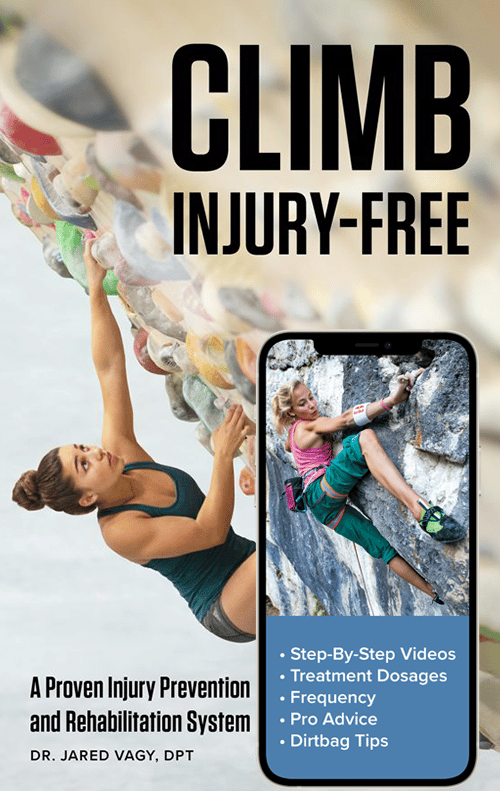S3, E1: TFCC injury – A Common Wrist Pain in Climbers -Kimmy Wiley
In this conversation, physical therapist Kimmy Wiley and Jared Vagy discuss TFCC wrist injuries in rock climbers. They cover the definition and location of the TFCC, common symptoms, and tests to diagnose the injury. They also discuss the importance of deloading and modifying climbing movements to avoid aggravating the injury. Kimmy shares her approach to rehab, which includes gradually building mobility and strength in a progressive manner. They emphasize the need for individualized exercises and the importance of pain management during the rehab process.
Kimmy Wiley’s Bio
Kimmy Wiley is a doctor of physical therapy and owner of Peak Pursuit Performance & Rehab- an online physical therapy and strength and conditioning service for outdoor athletes. While Kimmy has had experience in most physical therapy settings, she has found a passion for sports therapy- specifically for adventure sport athletics. During the winter months Kimmy travels with the U.S. Snowboard Halfpipe Team, helping them stay happy and healthy as they travel the world for training camps and competitions. When at home in Salt Lake, Kimmy can be found in the Wasatch Mountains climbing, snowboarding, or hiking with her dog, Nomad.
Takeaways
- TFCC injuries are common in rock climbers and can cause pain on the pinky side of the wrist during certain movements.
- Deloading and modifying climbing movements can help manage and prevent TFCC injuries.
- Rehabilitation should focus on gradually building mobility and strength, starting with exercises in a neutral range of motion and progressing to more challenging movements.
- Individualized exercises and pain management are important for successful rehab.
- The rehab process may not be linear and should be tailored to the individual’s needs and goals.
Listen on Apple Podcasts, Spotify, or wherever you listen to podcasts!
Timecodes
-
00:00 Introduction and Background
-
08:41 Rehabilitation Approach
-
25:16 Returning to Climbing and Specific Movements
-
32:32 Conclusion and Contact Information
If you would like to listen to the entire interview with Kimmy Wiley, check out the podcast. If you want to watch the interview, click the YouTube link or any of the timestamps above. If you would like to read quick sample of a concise recap of key interview topics and questions, check out the excerpt from the interview below.
Can you introduce yourself and share your background in working with climbers and wrist injuries?
I’m Kimmy Wiley, a physical therapist primarily working with climbers and outdoor athletes. Since graduating a few years ago, I’ve done some travel physical therapy, established a private practice focused on climbers, and recently traveled with the U.S. Halfpipe team. TFCC injuries are a common issue for climbers, which I explored in an article on diagnosis and foundational exercises. It’s rewarding to see how even small adjustments in training and rehab make a huge difference in recovery for active individuals.
What exactly is the TFCC, and why is it important?
The TFCC, or Triangular Fibrocartilage Complex, is a stabilizing structure at the base of the wrist on the pinky side. It comprises cartilage and ligaments that connect forearm bones to the smaller wrist bones. Essentially, it helps stabilize the wrist during weight-bearing, gripping, and impact activities. For climbers, this stabilizing role is essential because they often rely on wrist strength in extended or rotated positions. TFCC injuries can make those moves very painful and destabilize the wrist if not managed carefully.
What are the common symptoms of a TFCC injury?
Most climbers with a TFCC injury feel pain on the pinky side of the wrist. The pain is especially noticeable during ulnar deviation (moving the wrist toward the pinky) or extending the wrist under load. For example, mantling, where the climber’s wrist bears weight in an extended position, can be painful. Even yoga poses like plank or downward dog can aggravate the TFCC due to the pressure on an extended wrist. Sometimes, these athletes report that while regular climbing isn’t painful, certain exercises, or even daily tasks like pushing open a door, may trigger discomfort.
Are there specific tests to help identify a TFCC injury?
Yes, there are a few straightforward tests. First, checking for pain at the wrist’s pinky side helps pinpoint the issue. Pressing into that spot and feeling tenderness can be a sign of TFCC involvement. Another test involves ulnar deviation, or moving the wrist toward the pinky and adding slight pressure. If that movement triggers pain, it can further indicate a TFCC issue. I often have patients place their hands under a table and press upwards; if they feel pain on the pinky side, it’s another sign. Finally, stabilizing the TFCC area with tape or a supportive widget and then pressing down can reveal whether stabilizing the joint helps reduce pain, suggesting TFCC involvement.
How do you approach the rehabilitation process for a TFCC injury?
Initially, it’s essential to deload the wrist by modifying activities. This might mean climbing with some restrictions—avoiding aggravating motions like mantling or gas stones (where the wrist is extended or moved toward the pinky) and adjusting hand placements. I use the term “relative rest,” meaning you don’t need to avoid all activities, but rather modify them. For example, climbers might still work on grip strength with minimal wrist extension. Even minor changes to activities can make a big difference and prevent the injury from worsening.
Can you elaborate on modifying climbing and training activities to avoid aggravating the TFCC?
Yes. Modifications might involve skipping climbs that put excessive strain on the wrist or adjusting the angle of wrist extension. If wrist extension is painful, climbers can do push-ups on their fists or use a neutral grip to avoid full wrist extension. It’s also useful to reduce training volume to give the wrist time to recover. Planking with a neutral wrist position or swapping certain exercises for gentler ones also helps to maintain strength without overloading the wrist.
How should someone begin restoring wrist mobility once initial pain subsides?
Restoring mobility gradually is critical. You can start with simple, unloaded wrist movements like extension (bringing the wrist backward) without applying weight. Once that’s comfortable, introducing light weights or resistance bands is beneficial. Eventually, progressing to partial weight-bearing exercises like rocking forward in a quadruped (hands and knees) position can help prepare the wrist for full load-bearing movements, like planks or push-ups, in a safe and controlled way. This progressive approach helps build tolerance without overloading.
What types of exercises do you recommend starting with, and why?
I’m a big fan of isometric exercises (static holds) in a neutral wrist position, where the muscles activate without joint movement. This allows for safe strengthening with minimal joint strain. We might start with exercises like dumbbell holds or gripping a pull-up bar in a controlled manner to build foundational strength. Isometrics are great for strengthening without aggravating the injury, and then, as the wrist becomes stronger, we can move into more dynamic exercises.
Does finger position during wrist exercises matter in TFCC rehab?
Definitely. The position of the fingers can affect the wrist’s workload, so it’s worth considering based on your climbing goals. Holding an object with a closed fist provides one type of wrist activation, while an open hand, as in sloper holds, adds a different challenge. For climbers wanting to work on slopers, an open hand position will better mimic that movement. In general, variety in hand positioning enhances overall wrist strength, allowing you to prepare for a broader range of grips and demands.
Once strength begins to return, how do you prepare the wrist for more weight-bearing exercises like planks?
Planks and similar weight-bearing exercises are best approached with a progressive build-up. Start with a bear crawl position (hands and knees) and gradually shift more weight onto the wrists. You can also change hand positions by pointing fingers to the side, which reduces ulnar deviation and offers a safer starting point for some. As that feels more comfortable, transitioning to a full plank becomes easier. Then, single-arm planks or shoulder taps can further increase load-bearing capacity in a controlled way, letting the wrist adapt gradually.
How do you determine if the pain during rehab is safe or a sign of overloading?
Some discomfort is normal, especially when reintroducing weight-bearing. The key is in how long the pain lasts. If discomfort doesn’t persist beyond 24 to 48 hours, that’s a good sign. However, if pain lingers or worsens, it’s often a cue to scale back. This approach minimizes inflammation and the risk of setbacks. For example, if you experience wrist pain that prevents you from lifting something simple like a water bottle the next day, it’s a clear indication that adjustments are needed.
What other tools or exercises do you find helpful in TFCC rehabilitation?
Wrist wrenches are excellent tools that mimic climbing movements by resisting wrist flexion or extension. A wrist wrench involves a larger tube with a rope or weight hanging from it, which you twist to strengthen specific wrist motions. Dumbbells, PVC pipes, and bands are also useful, each providing unique resistance angles to enhance grip and wrist control. You can use bands to simulate the angles required in climbing, while dumbbells help develop wrist control in flexion and extension, both of which are critical in climbing.
Can you suggest exercises that are specific to the needs of a climber with a TFCC injury?
Climbing often involves closed-chain exercises, where the hand is fixed, and the body moves around it—think hangboarding or mantling on the wall. While open-chain exercises, like lifting a dumbbell, are good for building foundational strength, transitioning to closed-chain movements better prepares the wrist for climbing. For instance, practicing weight shifts in a plank position simulates the type of load you experience while climbing. Gradually introducing one-arm variations or rocking from side to side can further build control and resilience.
Is there a best approach to deciding on hand position or grip during wrist strengthening exercises?
The best approach depends on the climber’s personal goals and the type of climbing they’re focused on. For those who frequently climb slopers, an open grip with the fingers spread is useful, as it strengthens the wrist in an open-handed position. For climbers using a pinch grip more often, wrist curls with a closed grip mimic the demands of that movement. The key takeaway is to vary the exercises to create a strong, adaptable wrist.
What advice would you give someone who is ready to reintroduce complex movements like downward dog or planking in yoga?
Start by introducing weight gradually. Begin on all fours, keeping most weight on the knees, and rock gently onto the wrists. Adjust finger positioning (e.g., pointing fingers sideways) to find a comfortable angle. As comfort improves, move to a bear crawl, lifting the knees slightly off the ground, which builds strength without full loading. If that goes well, progressing to a full plank or downward dog is usually safe. This gradual approach minimizes the chance of aggravating the injury while maintaining consistent progress.
Do you have any additional exercises or routines that you recommend specifically for TFCC rehabilitation?
Beyond open- and closed-chain exercises, focus on creating balanced wrist strength across all movement directions: flexion, extension, ulnar and radial deviation, and forearm rotation (pronation and supination). Dumbbells or resistance bands work well for these motions. Wrist wrenches are particularly good for building rotational strength, and you can use them to mimic the loads encountered in climbing.
Are there specific parameters you use to decide if it’s safe to progress exercises?
Yes, I use a “no pain beyond 48 hours” rule as a general guideline. If the pain extends past that period, it’s typically an indicator to dial back. Additionally, some climbers find that using props, like heavier dumbbells, can help them perform exercises without painful wrist extension. A gradual approach that respects these boundaries reduces injury risk while allowing the wrist to adapt.
How important is consistency when managing a TFCC injury in climbing?
Consistency is crucial. The wrist, like any joint, responds well to steady, progressive loading. Since wrist injuries can easily flare up with sudden movement increases, having a clear, consistent plan that allows for incremental progress is essential. The wrist is a complex joint with various movement planes, so developing strength across all directions not only speeds recovery but also builds long-term resilience for climbing.
What’s one overarching principle to keep in mind for anyone managing a TFCC injury?
Progress in stages, be mindful of discomfort, and don’t rush back into full-intensity climbing. Although climbers might be eager to get back, rushing rehab often leads to setbacks. The goal should be a gradual, thorough rehab that leaves the wrist stronger than before.
Do you have a short rhyme or phrase for remembering TFCC injury management?
Here’s one to keep in mind: “If pain lingers for a day or two, dial it back—that’s your cue. Keep it steady, not insane, and soon you’ll climb without the strain.” Simple but true!
How can people learn more about your work or reach out for guidance?
The best way to reach me is through Instagram or email at Peak Physio & Performance. I work hard to reply to DMs and emails as timely as possible and am always happy to connect and support climbers looking to stay injury-free and enjoy the sport they love.
- Disclaimer – The content here is designed for information & education purposes only and the content is not intended for medical advice.




